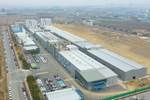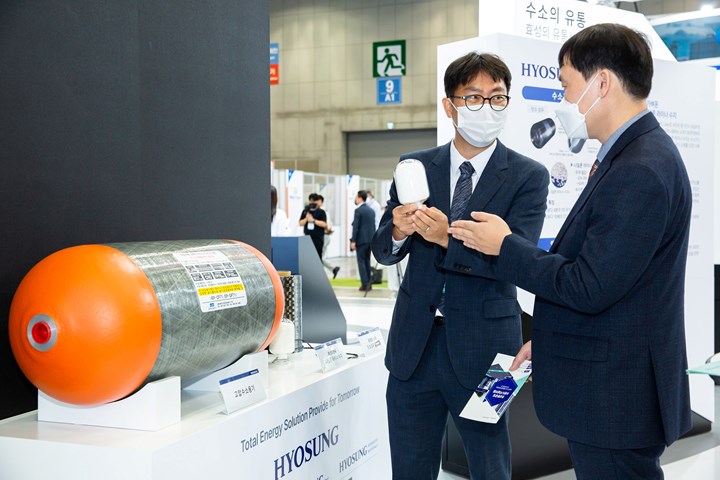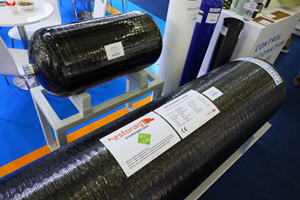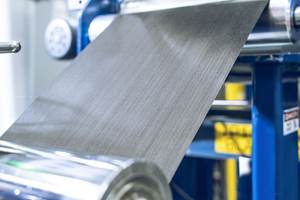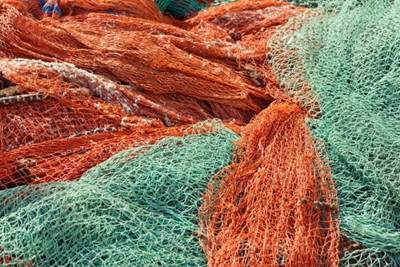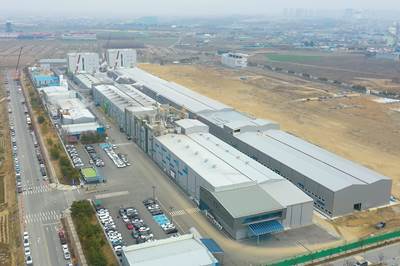Hyosung transforms nylon for use as liner in hydrogen fuel tanks
The company has succeeded in developing and using nylon as a core liner material in hydrogen storage vessels, overcoming metal and HDPE liner alternatives.
Hyosung TNC (Seoul, South Korea), a comprehensive fiber manufacturer, has announced that it has succeeded in developing and using nylon for the liner material — a core component to prevent gas leakage — of hydrogen vehicle fuel tanks with its own technology, the first of its kind for a Korean company.
Hyosung TNC’s nylon material is said to be superior to conventional metal and high-density polyethylene (HDPE) liner materials in terms of light weight, gas barrier and impact resistance. Specifically, the nylon liner material is 70% lighter than metal and 50% lighter than HDPE. Its gas barrier property is also reported to be 30% higher than metal and 50% higher than HDPE, effectively improving hydrogen gas leakage.
Conventional metal liners are heavy with a high risk of brittleness when exposed to hydrogen for a long period of time, whereas the nylon liner is said to have a low hydrogen absorption and air permeability, eliminating potential brittleness. HDPE liners, which are used as high-pressure containers at 400-bar levels, cannot withstand the 700-bar pressure required by typical hydrogen electric vehicles.
In addition, the hydrogen container liner must be able to withstand rapidly changing temperature fluctuation caused by frequent charging and discharging of hydrogen. Hyosung says this is solved through the nylon liner’s optimized impact resistance from -40ºC to 85ºC.
The development has laid the foundation for Hyosung TNC to enter the nylon liner market. According to H2 Research, the import substitution effect of the nylon material liner market is expected to grow to about 270 billion won (approximately $180 billion) annually in 2030. In addition, with the expansion of various hydrogen mobility markets such as hydrogen electric vehicles, drones, trams, ships and urban air mobility (UAM), nylon is expected to gain more attention as a liner material for hydrogen containers.
In addition, as Hyosung TNC works to develop what is says will be the first recycled nylon fiber technology from recycled fishing nets discarded in the sea.
Ultimately, the novel nylon liner is expected to contribute to the completion of Hyosung’s hydrogen value chain, which currently includes hydrogen charging stations in Korea, construction of liquefied hydrogen plants and liquefied hydrogen filling stations.
“Hyosung TNC’s development of nylon liner material demonstrates, even in the textile industry, which has been regarded as a declining industry, [that] the innovation that transforms it into a key material for the high-tech hydrogen industry can happen if it’s supported by technology,” chairman Cho Hyun-Joon says. “We will contribute to the development of the future eco-friendly energy industry with the technology of materials and textiles.”
Hyosung TNC’s nylon-applied hydrogen container passed the hydrogen container international quality standard (UN/ECE R134) in June 2022. The company also plans to conduct commercial tests in cooperation with hydrogen fuel tank manufacturers and automakers. It expects to expand the application of nylon as a liner material from tube trailers of commercial trucks to CNG and hydrogen vessels sailing the seas globally, such as Antarctica and the Equator, by enhancing the impact and heat resistance range from -60ºC to 90ºC.
In addition, as Hyosung TNC works to develop what is says will be the first recycled nylon fiber technology from recycled fishing nets discarded in the sea, it plans to expand the eco-friendly plastic material market by applying recycled nylon to a liner material in the future.
Related Content
On the radar: Cryogenic testing of composites for future hydrogen storage
Netherlands, U.K., France, Germany and the U.S. build up test capability, look at thermoset and thermoplastic composite materials.
Read MoreMikrosam, H2Storage collaborate on 300+-liter Type IV hydrogen tanks
Automated filament winding cell achieving wind speeds of 6 meters/second improves production performance, shortens curing cycle for serial production of 700-bar Type IV tanks.
Read MoreHexagon Purus Westminster: Experience, growth, new developments in hydrogen storage
Hexagon Purus scales production of Type 4 composite tanks, discusses growth, recyclability, sensors and carbon fiber supply and sustainability.
Read MoreDemonstrating composite LH2 tanks for commercial aircraft
Toray Advanced Composites and NLR discuss the Netherlands consortium and its 4-year project to build demonstrator liquid hydrogen tanks, focusing on thermoset and thermoplastic composites.
Read MoreRead Next
Avient launches reclaimed nylon-based long fiber composites
The post-consumer recycled nylon 6 material is reclaimed from end-of-life fishing nets, reducing ocean-bound plastic waste while fostering material deployment for demanding environments.
Read MoreHyosung to add fourth carbon fiber line in South Korea
The $38.5 million expansion will bring the company’s total carbon fiber capacity to 9,000 metric tonnes per year.
Read MoreFrom the CW Archives: The tale of the thermoplastic cryotank
In 2006, guest columnist Bob Hartunian related the story of his efforts two decades prior, while at McDonnell Douglas, to develop a thermoplastic composite crytank for hydrogen storage. He learned a lot of lessons.
Read More


